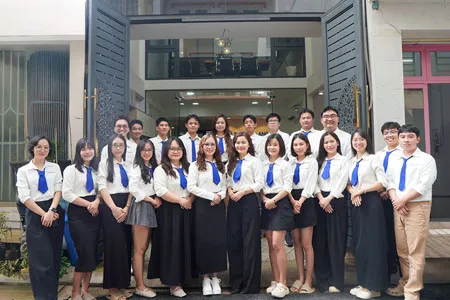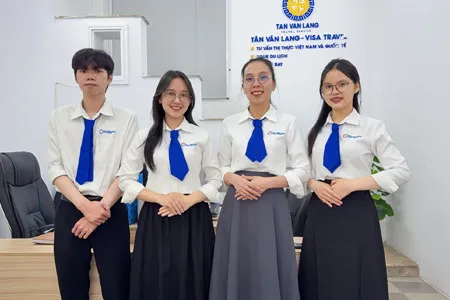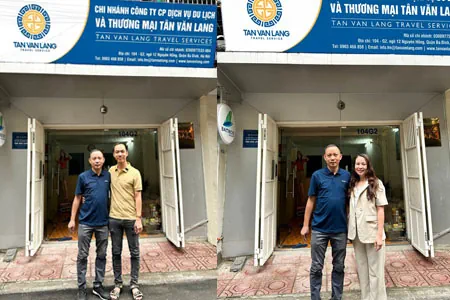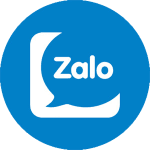When it comes to Vietnam visa for Indians, the short answer is clear: yes, Indian passport holders must obtain a valid visa to enter Vietnam, except for a limited exemption when traveling directly to Phu Quoc island. With the expansion of eVisa policies and simplified online application systems, the process has become much easier than before.
However, knowing exactly which type of visa suits your trip, what documents are required, how much it costs, and how to avoid rejection is crucial. In this guide, I’ll walk you step by step through everything you need to know, based on my years of experience consulting Indian travelers at Tân Văn Lang Visa Services.
If you’re planning your first trip to Vietnam – or even if you’ve been here before but want to avoid mistakes- read carefully below.
Do Indian citizens need a visa for Vietnam?
Yes, all Indian citizens are required to obtain a visa before entering Vietnam. The only exception is for those flying directly to Phu Quoc island from outside Vietnam, staying there for no more than 30 days, and departing to another country afterward. In every other situation – whether you travel for tourism, business, or visiting relatives – you must apply for a visa.
Currently, the most popular visa options for Indians are:
- Vietnam eVisa for Indians – available for both single-entry and multiple-entry stays, valid up to 90 days.
- Visa on Arrival (VOA) – still possible in emergencies, but requires a pre-approval letter.
- Visa at the Embassy of Vietnam in India – a traditional option for those who prefer submitting documents in person.
The Vietnamese government has made great efforts to digitize immigration processes, making the eVisa the most convenient choice for Indian travelers in 2025.
Popular types of Vietnam visa for Indians
Depending on the purpose of your trip, application channel, and duration of stay, Indian citizens can apply for different categories of visas:
By method of application
- E-visa: Applied online and approved electronically. You’ll receive your visa via email in PDF format.
- Visa on arrival: Requires a pre-approval letter from the Vietnam Immigration Department and is collected at the airport. Recommended only for last-minute cases.
- Embassy visa (visa sticker): Applied directly at the Embassy of Vietnam in India.
By purpose of visit
- Tourist visa – for leisure trips, sightseeing, and cultural exploration.
- Business visa – for attending meetings, trade events, or working with Vietnamese partners.
- Relative visit visa – for those who have family members living in Vietnam.
By duration and entries
- 30 days single-entry visa
- 30 days multiple-entry visa
- 90 days single-entry visa
- 90 days multiple-entry visa
Each option comes with its own requirements and costs, which I’ll detail in the following sections.
A detailed guide to applying for a Vietnam E-visa for Indians
The Vietnam eVisa is currently the most preferred option for Indian citizens. It is fast, affordable, and eliminates the need to visit the embassy.
Basic requirements
To successfully apply for a Vietnam eVisa for Indians, you must prepare:
- A passport valid at least 6 months beyond your entry date and with at least 2 blank pages.
- A scanned copy of your passport data page (JPEG format).
- A recent portrait photo in JPEG format that meets the Vietnam visa photo requirements.
- A valid debit/credit card for online payment.
Step-by-step process
- Complete the secure online visa application form and pay the fee.
- Receive your approved eVisa letter via email within the processing time you selected.
- Print out the eVisa letter and present it to Vietnam Immigration upon arrival.
Processing time
- Standard processing: 5-7 working days
- Expedited options: 4 days, 3 days, or even 2 days for urgent travel
- Emergency cases: Available 24/7 via hotline support
Ports of entry
Indian citizens must enter through the exact airport, land border, or seaport specified in their eVisa application. Vietnam currently allows entry through 13 airports, 16 land border gates, and 13 seaports, including popular ones such as Noi Bai (Hanoi), Tan Son Nhat (Ho Chi Minh City), and Da Nang Airport.
Procedure for applying for a visa at the Embassy of Vietnam in India
For travelers who prefer the traditional way, you may apply directly at the Embassy of Vietnam in New Delhi or the Consulate General of Vietnam in Mumbai.
Steps to apply at the embassy
- Fill out the printed visa application form.
- Prepare the required documents (passport, photos, invitation letter if applicable).
- Submit them in person or by post to the Embassy/Consulate.
- Pay the visa fee (varies depending on visa type and duration).
- Collect your visa sticker once it is issued.
This method is more suitable for those who:
- Need a longer-term visa beyond 90 days, which eVisa currently does not support.
- Want a physical visa sticker in their passport for business or legal reasons.
- Are not comfortable with online applications.
Comparison between E-visa and visa sticker at the embassy
Both options are valid, but they differ in convenience, processing speed, and flexibility.
| Criteria | Vietnam eVisa | Visa at Embassy (sticker) |
|---|---|---|
| Application method | Online | In person/by post |
| Validity | Up to 90 days | Longer-term visas possible |
| Entries allowed | Single/multiple (30-90 days) | Flexible, may exceed 90 days |
| Processing time | 5-7 working days | 5-10 working days |
| Cost | Lower, fixed fee ($25 single entry, $50 multiple) | Higher, varies by type |
| Best for | Tourists, short-term business trips | Long-term stays, official purposes |
For most Indian travelers in 2025, the Vietnam eVisa remains the best choice—simple, affordable, and quick. However, frequent business travelers or those needing long-term stays may find the embassy option more appropriate.
Complete checklist of documents for a Vietnam visa in 2025
Whether you apply for an eVisa, visa on arrival, or embassy visa, the following documents are typically required for Indian citizens:
- Valid passport (at least 6 months validity, 2 blank pages).
- Completed visa application form (online or paper-based).
- Passport-sized photos meeting official requirements.
- Travel itinerary (flight bookings, hotel reservations, or invitation letter).
- Business-related documents (if applying for a business visa, such as an invitation letter from a Vietnamese company).
- Proof of relationship (if applying for a relative visit visa).
- Visa approval letter (for visa on arrival).
At Tân Văn Lang, we always advise our Indian clients to double-check every document before submission, as even small mistakes (wrong spelling, mismatched passport number) can delay or jeopardize approval.
Updated Vietnam visa fees for Indian citizens
One of the most important considerations when planning your trip is the Vietnam visa cost for Indians. The fees depend on the type of visa, processing speed, and number of entries. Below is an updated breakdown for 2025 when applying through trusted visa service providers [1] :
| Visa type | Processing time | 1-2 applicants (USD/person) | 3-4 applicants (USD/person) | 5+ applicants (USD/person) |
|---|---|---|---|---|
| 30 days single entry | 5-7 working days | 48 | 47 | 46 |
| 4 working days | 66 | 65 | 63 | |
| 3 working days | 71 | 70 | 69 | |
| 2 working days | 79 | 78 | 77 | |
| 30 days multiple entry | 5-7 working days | 73 | 72 | 71 |
| 4 working days | 91 | 90 | 88 | |
| 3 working days | 96 | 95 | 94 | |
| 2 working days | 105 | 104 | 103 | |
| 90 days single entry | 5-7 working days | 50 | 49 | 48 |
| 4 working days | 66 | 65 | 63 | |
| 3 working days | 71 | 70 | 69 | |
| 2 working days | 79 | 78 | 77 | |
| 90 days multiple entry | 5-7 working days | 78 | 77 | 76 |
| 4 working days | 96 | 95 | 93 | |
| 3 working days | 99 | 98 | 97 | |
| 2 working days | 105 | 104 | 103 |
Note: If you apply directly on the official website, the fee is US $25 for single entry and US $50 for multiple entries. However, this does not include support, emergency handling, or corrections in case of errors.
That’s why many Indian travelers prefer applying through an authorized visa consultancy like ours at Tân Văn Lang – we ensure faster approvals, error-free applications, and 24/7 assistance if you need last-minute changes.
Processing time and important notes
The Vietnam visa processing time for Indians depends on the method you choose:
- eVisa via government website: Usually 3-5 working days, but delays are possible.
- eVisa via service provider: 2-7 working days, with guaranteed expedited options (even within 24 hours for emergencies).
- Embassy visa: Typically 5-10 working days, depending on the type.
- Visa on arrival: Approval letter can be arranged in as little as 1-2 working days, but actual stamping depends on airport immigration.
Important notes
- Apply at least 7 working days before departure to avoid stress.
- Double-check your port of entry—you can only enter through the one listed on your eVisa.
- Vietnam does not allow extensions of eVisas at the moment. If you need to stay longer, you must exit and reapply for a new visa.
- Frequent back-to-back eVisa applications may raise suspicion at immigration and could lead to entry refusal.
Common reasons for Vietnam visa rejection
Although most Indian travelers receive their visas smoothly, there are still cases of rejection. From my consulting experience, the most common reasons include:
- Incorrect or incomplete documents – wrong passport number, low-quality photos, or missing fields.
- Passport validity under 6 months – a strict rule in Vietnam immigration law.
- Suspicious travel patterns – multiple short visits that appear inconsistent with the stated purpose.
- Mismatched entry details – applying for one port of entry but trying to enter from another.
- Security alerts or blacklists – rare, but can affect travelers flagged in the immigration system.
Tip: If your visa is rejected, you will not receive a refund of the government fee. That’s why it is safer to apply through a consultant who checks everything before submission.
Essential tips for entering Vietnam
Even with a valid visa, entry is not guaranteed – you must still pass immigration checks. To ensure a smooth arrival in Vietnam, remember these tips:
- Carry a printed copy of your eVisa (digital versions on your phone may not be accepted).
- Have your return ticket or onward travel proof ready. Immigration may ask for it.
- Keep your hotel booking confirmations or invitation letters accessible.
- Ensure your passport is not damaged – even minor tears can raise issues.
- Be polite and cooperative with immigration officers; avoid arguments.
- If traveling for business, carry supporting documents (invitation, company letters).
As a consultant, I’ve seen many Indian travelers denied boarding simply because they forgot to print their eVisa letter. Don’t make that mistake – prepare in advance.
Frequently Asked Questions (FAQ)
How long does it take to process a Vietnam E-visa for Indians?
Most applications are processed within 3-5 working days. However, 20% of cases may take longer if additional verification is required. With a service provider, you can get approval in as little as 2 working days or even within 24 hours in emergencies.
Can I get a visa on arrival at the airport?
Yes, but only if you have a pre-approval letter from the Vietnam Immigration Department. Without this document, airlines will not let you board. For urgent trips, visa on arrival is recommended, but applying for an eVisa in advance is always safer.
What is the maximum stay allowed with a Vietnam E-visa?
Currently, the maximum is 90 days, either single-entry or multiple-entry. Longer stays require applying through the Embassy of Vietnam in India.
If my E-visa application is rejected, will I get a refund?
No. The government fee is non-refundable under any circumstances. This is why it’s important to prepare documents carefully or work with a trusted visa service.
Do I need to provide proof of financial status for the visa application?
Generally, no. For standard eVisa applications, proof of funds is not required. However, if you apply at the embassy for long-term visas, additional documents like bank statements or employment proof may be requested.
Do I need to book a round-trip flight ticket before applying for a visa?
Not always. While eVisa applications don’t require flight bookings, airlines at departure airports may ask for proof of onward travel. It is highly recommended to have a return or onward ticket to avoid boarding issues.
What is the difference between a single-entry and a multiple-entry visa?
- Single-entry visa: You can enter Vietnam once. If you leave, the visa is no longer valid.
- Multiple-entry visa: You can enter and exit Vietnam multiple times within the visa validity period (30 or 90 days).
Securing the right Vietnam visa for Indians is the key to a stress-free journey. With options like eVisa, embassy visa, and visa on arrival, Indian travelers now have more flexibility than ever. But each path comes with its own requirements, fees, and risks.
As a consultant at Tân Văn Lang Visa Services, I always recommend:
- Choose the eVisa if you’re traveling short-term (tourism, business meetings, family visits).
- Opt for the embassy visa if you need a longer stay or for official purposes.
- Keep documents neat and accurate – mistakes cost both time and money.
If you want a hassle-free experience, our team is ready to handle the application for you – from preparing documents, ensuring photo compliance, paying the government fee, to delivering the approved eVisa straight to your inbox. With us, you minimize the risk of rejection and save valuable time.
So, whether you’re planning to travel to Vietnam for leisure, business, or family visits, the process doesn’t have to be stressful. Let experts handle the paperwork while you focus on planning your journey.







 Vietnam visa for Zimbabwe citizens 2025– Simple guide & fastest application process
Vietnam visa for Zimbabwe citizens 2025– Simple guide & fastest application process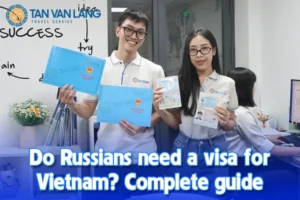 Do Russians need a visa for Vietnam? Complete guide 2025
Do Russians need a visa for Vietnam? Complete guide 2025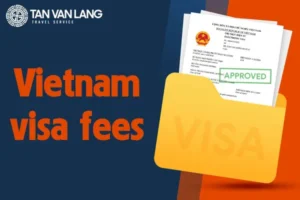 Vietnam visa fees: Updated costs & What travelers should expect 2025
Vietnam visa fees: Updated costs & What travelers should expect 2025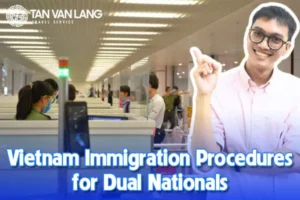 Vietnam Immigration Procedures for Dual Nationals in 2025
Vietnam Immigration Procedures for Dual Nationals in 2025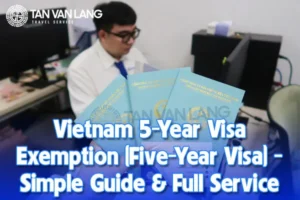 Vietnam 5-Year Visa Exemption (Five-Year Visa) – Simple Guide & Full Service
Vietnam 5-Year Visa Exemption (Five-Year Visa) – Simple Guide & Full Service Vietnam Visa for Yemeni Citizens 2025 – Full Guide to Requirements, Application & Fees
Vietnam Visa for Yemeni Citizens 2025 – Full Guide to Requirements, Application & Fees